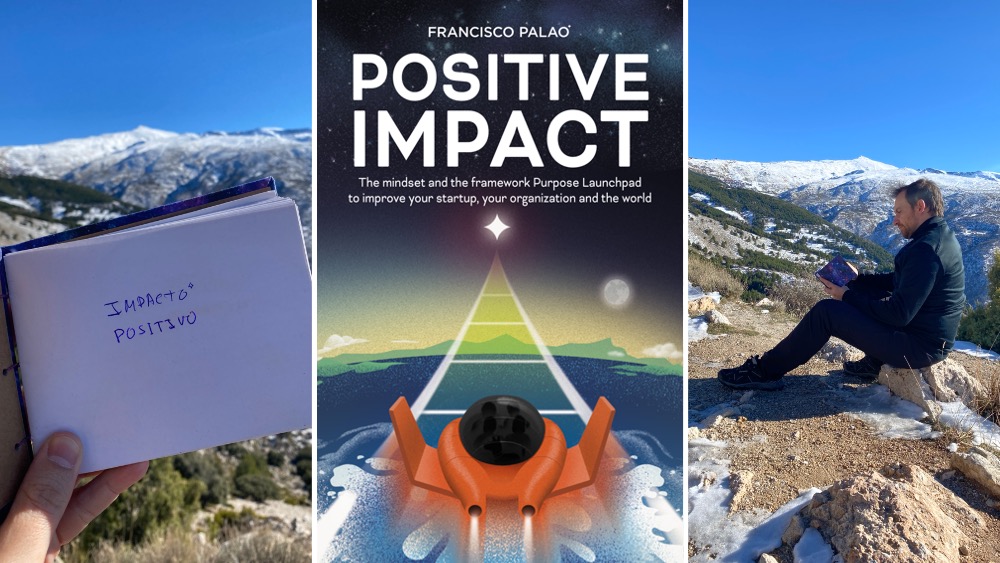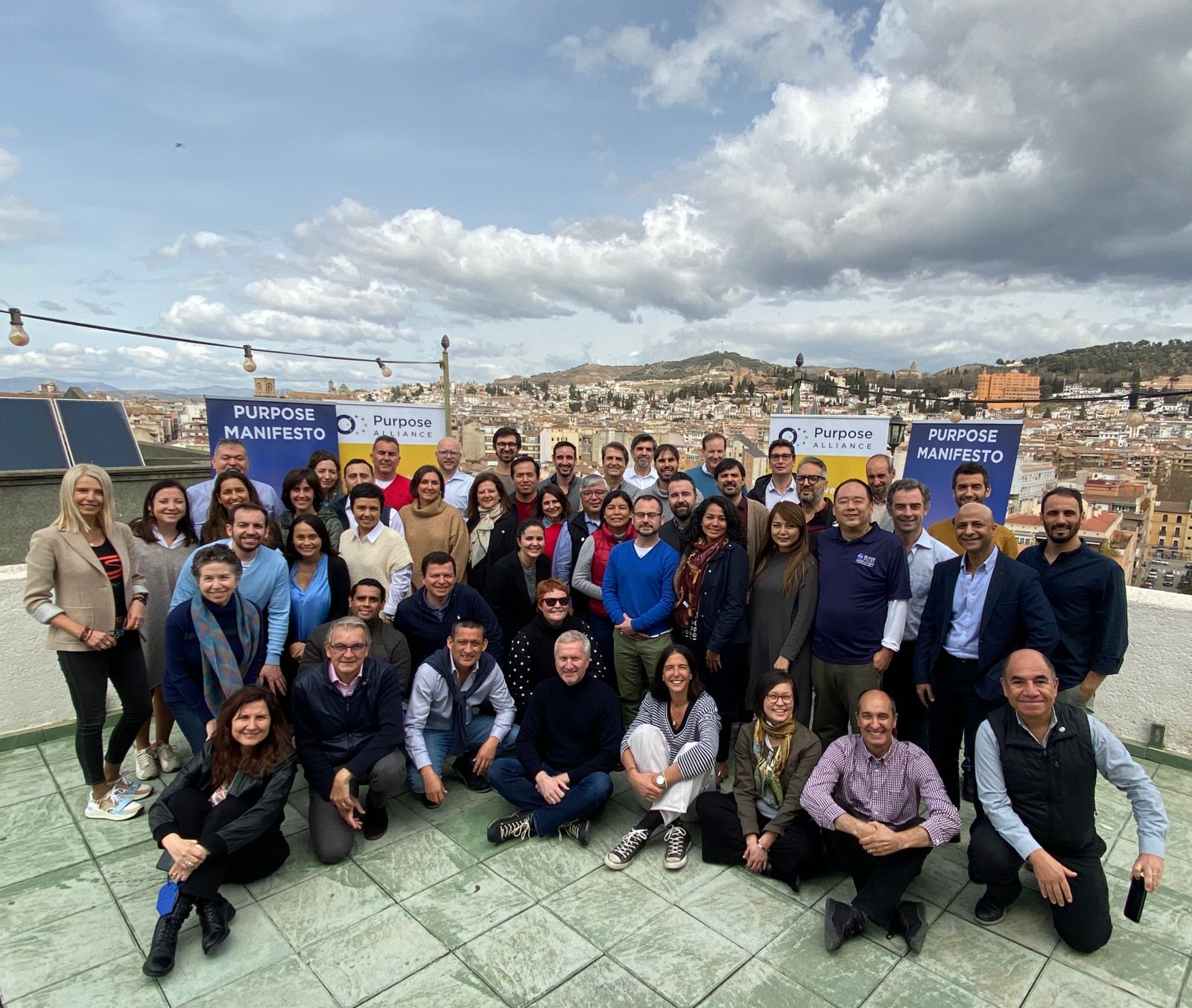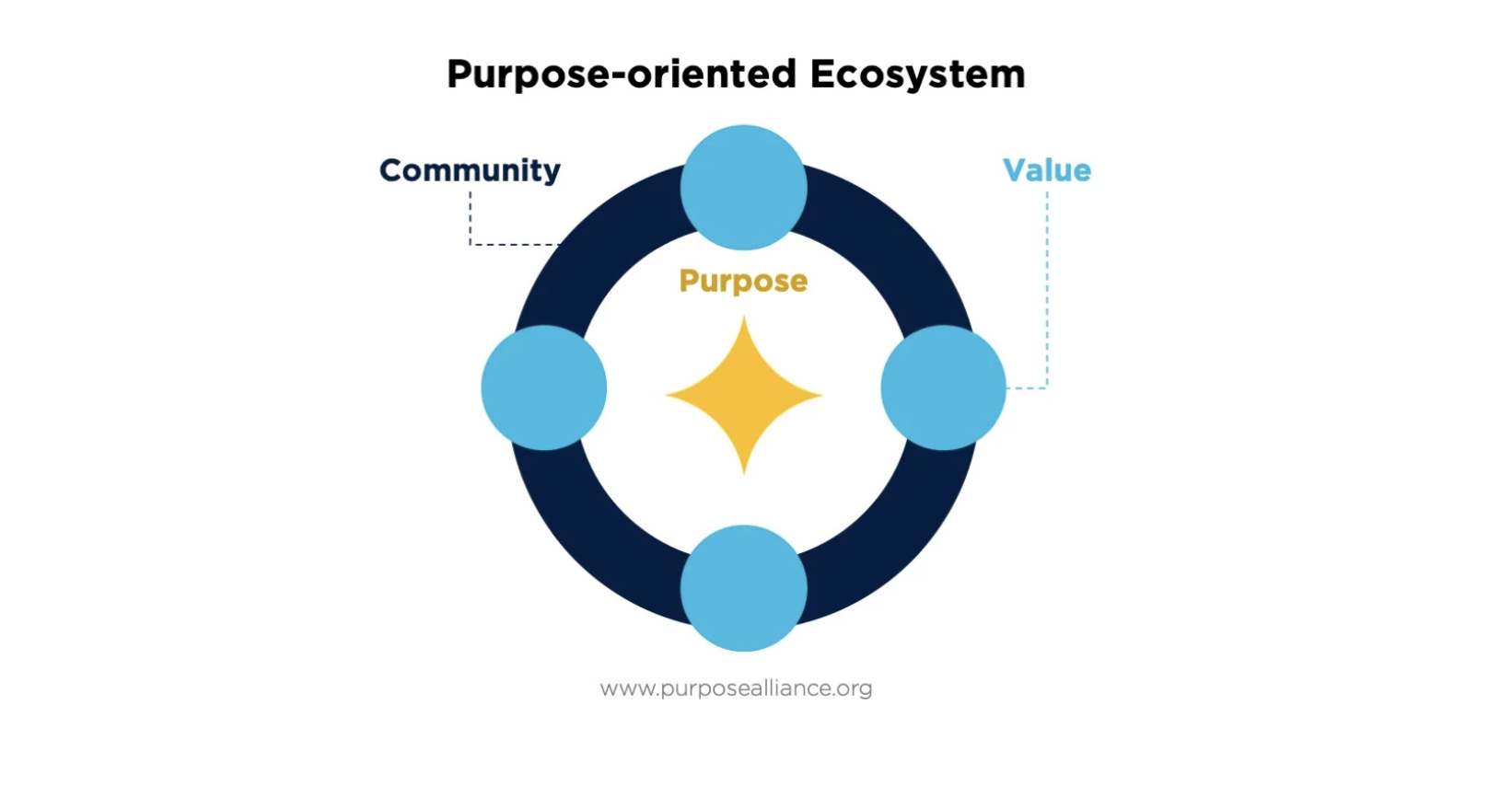Authors: Roberto Mario DeStefano and Vittorio Sommella (Purpose Launchpad Mentor)
Introduction
For my Economics Management and Global Policies Master’s Degree final thesis, I carefully studied the Exponential Organizations (ExO) model with the ultimate goal of understanding if it could be applied to SME’s in the particular Italian landscape. Some very interesting findings have emerged so far from the empirical evidence. In particular, how the majority of the people interviewed (part of both Purpose Alliance and OpenExo Community) highlighted how the original model necessarily undergoes an evolution that leads to a purpose-driven ecosystem structure.
The search for a purpose is becoming an increasingly pervasive topic both at an academic and professional level. In particular: “Both individuals and organizations need to make sense of their existence. We need to do things that make us feel alive, that make us believe in what we do, and that makes us feel that what we do makes sense. “(Palao, Purpose Alliance 2021).
Considering the growing attention around this important subject, and thanks to the valuable guidance and contribution of Vittorio Sommella and some other members of this extraordinary community, I also wanted to deepen, the position of numerous prominent authors who have certainly validated and projected the purpose to certainly become one of the most relevant and discussed topics of these times of deep change:
• Simon Sinek in “Starting from a why” argues that few companies or people can clearly articulate why they do what they do;
• Gene Corfield of HBR (Harvard Business Reviews) presents how the purpose can be declined on 3 different levels;
• Microsoft’s C.E.O. Satya Nadella, recently highlighted: “It is in times of great upheaval and uncertainty that our ability to stay grounded in our sense of purpose and stay true to our identity is of the utmost importance.”
I hope you will enjoy these considerations and findings.
Kindly,
Roberto.
General considerations about the inception of Purpose-driven ecosystems. Written by: Roberto Mario De Stefano, Vittorio Sommella.
Inception and evolution of Exponential Organizations.
Since 1955, 90% of the Fortune 500 companies have disappeared and, as of 2021, only 52 companies appear in both lists. At the current churn rate, about half of today’s S&P 500 firms will be replaced over the next 10 years (Perry, a, 2021)
Why so?
As we now know, the last two decades have been strongly characterized by the advent of numerous changes to society due to the introduction of many technological innovations. These innovations had a major impact on many aspects of our lives. Robotics, nanotechnology, 3D printing, 3D printing, artificial intelligence, to name a few, and combined with an abundance of information, have considerably modified the scenario and the perspectives at the entrepreneurial and corporate level. In some ways, such a large turnover of companies might indicate a very dynamic market, however, it hides a much broader and interesting reality. Many companies were already in a critical condition way before 2020, but the Covid-19 pandemic has escalated the difficulties of the situation and accelerated the need for a radical change.
In this scenario, many companies are simply no longer able to be competitive. As Peter Diamandis said, “they do not have the necessary skills to continue surfing on the crest of the tsunami of the fourth industrial revolution, which would prevent them from being overwhelmed”. Operating in this context of uncertainty and volatility, it becomes difficult not only to compete but to stay alive. Technological, economic, and sociological changes (Marchese, Corso, Gastaldi, 2020), combined with the convergence of strategic forces – such as globalization and hyper-competition – have generated an intensification of management challenges (Hamel G., Turner N., 2012, 2018).
In addition, markets are mutating fast and technologies continue to disrupt the game for entire industries, companies, and people. Such dynamism is well described by the V.U.C.A. (Volatility, Uncertainty, Complexity, and Ambiguity), an acronym introduced towards the end of the Cold War to describe the emergence of a completely new global landscape that requires innovative and different approaches in both business and society.
In this scenario, only a specific breed of companies (such as Google, Tedx, Uber, Airbnb, Zoom just to name a few) seemed to be extremely resilient and even leverage certain elements to produce a disproportionately large impact compared to their peers (Perry, aei, 2014).
Exponential Organizations (or ExOs) emphasize their ability to tame V.U.C.A. and follow an exponential growth path (Ismail, Palao, Lapierre, 2019). It can be said that ExOs can compete in a VUCA world by implementing unconventional organizational models (polyarchy, flat organization, etc.) by exploiting innovative ecosystems and digital platforms. What characterizes ExOs is that the level of disruption they bring to their industries and fields. Taming the emptiness is one of the most important characteristics to become exponential organizations (Hamel G., Turner N., 2012, 2018). In the first book “Exponential Organizations” we learned how real ExOs have an MTP “Massive Transformative Purpose”; their highest aspiration, the ultimate goal of the organization itself. At the backbone of the exponential organizations, we find the MTP: the very first of the eleven attributes, without which it seems impossible to define a company as an ExO. An MTP becomes the conditio sine qua non for developing and evolving all other attributes (S.C.A.L.E and I.D.E.A.S). It is the world you want to achieve (Palao, Herrera, 2021).
As C-level executives and top managers became more familiar with the ExO model, the natural question became “how to” transform into an ExO; how to deal with the corporate immune system’s compulsion to block innovation and change, learn how to implement the right innovation-oriented methodologies and use a learning approach to build internal organizational capabilities? how to diverge from a linear business model, connect to abundance, and truly become exponential? (Ismail,Palao,Lapierre, 2019). That is when founders, contributors, professionals, and people from the ExO ecosystem recognized the need for a different type of journey. The realization that the transformation of an organization does not come from the artificial introduction and implementation of the ExO attributes but from the evolution of people at the heart of the organization itself. The step-by-step process outlined in the book “Exponential Transformation” is the culmination of the ExOs professionals and experience in executing innovation and transformation projects over the last 15 years, involving more than 200 innovation consultants who have provided essential feedback.
However, even though the ExO Sprint model offers many practical solutions for tackling the transformational challenge, it is the mindset that becomes the key attribute of this activity.
So, how do some of the protagonists of ExO model see the realization of this evolution? Here’s an extract of the analysis conducted by Roberto Mario De Stefano in his thesis “The exponential organization model: a study on its applicability to Italian SMEs”. Listed are some of the answers to a specific question: “What is the evolution of the exponential model and how do you see it changing in next 10 years?”
The following analysis was carried out using a qualitative analysis software called “Taguette”, with this application it is possible to enter source codes taking into account certain keywords, to highlight and outline the most recurrent concepts.
The keywords referred are the following: Ecosystems, Purpose, ExO, MTP, Model, Value, Leverage, Attributes, Improvement, Transformation.
From the original twenty-two interviews conducted (you can find them at this link), we extrapolated some key concepts and opinions that we present herein forth. The main idea that emerges from the empirical evidence is that the model is rapidly evolving towards an increasingly purpose-driven ecosystem structure. This idea, shared by several interviewees, is also strongly supported by the authors, who, thanks to this analysis, found the evidence to formulate the basic hypothesis of this paper.
Starting from the most common evidence, we want to start with Francisco Paloao who from his direct experience and thanks to the contribution of 150 people from 25 countries, underlines the concept of Purpose, creating an entire model around it. “I believe that new environments will emerge in which the concept of organizations may become obsolete or less relevant in the future. I believe that beyond technologies and abundance the key element of everything we do is the ‘why’, and that is the purpose which is one of the key elements of exponential organizations and one of the things society cares about most nowadays. It’s no longer just about growing, it’s about the impact that each of us can have on the world. And at the same time, I see that every day the concept of organization is less relevant, and we can see the emergence of ecosystems, made up of many organizations working together at the same time towards a common goal’.
Also, Salim Ismail theorizes a similar hypothesis, albeit with different nuances:
“We are preparing for the second edition [of Exponential Organizations], we strongly believe that the model is very solid. What may change is the emphasis on the different attributes. For the first one, I think six, eight years MTP was really important and we are seeing a lot of companies having an MTP focus. Now the two big ones, in my opinion, will be the community, to create a fan base and an environment around you. The second is algorithms, as we have more and more data sets and more analytics that we can do. I think those two are going to be very important in the next few years.
As previously mentioned, Vittorio Sommella also strongly supported this thesis: “We are already in a phase of evolution! When a model becomes relevant, it already needs an evolution. And, the evolution will be about giving more attention to the human factor. The MTP must not become just a slogan to gather a community of individuals, but an engine to make companies act to shape a better future (and not just to create economic benefits). Purpose-driven companies can join forces and create synergies to pursue and realize common visions within interactive ecosystems. I would say this has to start with people, ideally creating mechanisms to understand how to use the abundance of the world. So, maybe the evolution may start from schools, from children as key people to drive change as it becomes fundamental to start from the bottom, from start-ups and entrepreneurs.”
On the same wavelength, there are opinions of many additional influential community members such as Francesco Derchi and Luca Leonardini. Corina Almagro, despite considering it very difficult to make predictions, states that Purpose-driven organizations will emerge as more meaningful and stronger realities. Matteo Pacini support adds the concept of sustainability to it: “humans want to be well. As our basic needs are met by an abundance of goods, the search for meaning emerges. So, if companies include a higher purpose in their value proposition, they can create (and then extract) additional value for us. And given that high purposes are massive and universal, companies shall cooperate to the end they pursue and eventually generate purpose-driven ecosystems. This is parallel to and independent from the ExO model: it’s one of the effects of abundance in society. The ExO model instead prescribes how to leverage that abundance to generate maximum value. Regarding the evolution of the ExO model, I believe sustainability is key. Being exponential is powerful and smart. Being purposeful is good and attractive. But being sustainable is unavoidable, for all of us. We should include it in all our models as a necessary constraint to respect.”
Toward Purpose-driven Ecosystems
In March 2021, Microsoft CEO Satya Nadella wrote a letter to employees: “It is in times of great disruption and uncertainty that our ability to remain rooted in our sense of purpose and stay true to our identity is of the utmost importance.” Purpose has never been more urgent than it is now, in the face of an unpredictable pandemic where standards of care are evolving by the hour and everyday healthcare heroes represent our best hope. Ask yourself: where does your purpose lead in this need-driven moment (Harvard Business Review; Scott Goodson, Ali Demos, and Charles Dhanaraj, 2021).
Starting with purpose is now becoming a prerogative of many companies, but many authors have introduced the issue. It becomes evident the evolution toward a purposeful economic system and society.
Simon Sinek in “Starting from a why”, argues that only a few companies or people can clearly articulate why they do what they do. It is not about how to run a profitable business, but about the purpose. Sinek asks: Why does your company exist? Why do you get up in the morning? And why should anyone care? (Simon Sinek, 2009)
Gene Corfield of HBR (Harvard Business Reviews) argues that purpose can be considered on 3 different levels:
-
Big purpose Purpose. It describes the company’s role in the world, this is because the company’s purpose best galvanizes customers when the stated purpose reflects what the company shares with them, not just what the company does for them.
-
Average purpose Purpose. It describes its role in customers’ lives. Companies with only one brand may opt for the company and brand purpose to be the same thing. Or they may choose to have separate company and brand purposes, especially if they have multiple divisions that serve different customer needs.
-
Small business Purpose. Despite its name, the small business purpose has by far the greatest impact on business performance and market leadership. Customer purposes are all the intentions, needs, questions, or desired outcomes that might compel a customer to engage with your company.
These many needs constitute the customer’s portfolio of goals (Harvard Business Review, Gene Cornfield, 2021).
Francisco Palao recognized the need of positioning “the Purpose” as the very driving force to guide society, people, and organizations in this new economic and social era of impact creation. In particular, he described how some Exponential Organizations are becoming Purpose-driven Ecosystems in his article “Industries create scarcity, purpose creates abundance”. (Palao, Purpose Alliance, 2021)
To evolve an idea into a meaningful and impactful initiative, the alignment of personal values and the organization’s Purpose among all stakeholders, become an indisputable key element for the creation of a modern organization and a better society. In such a great endeavor, it becomes crucial the acquisition of a specific mindset that results in the adoption of key principles such as exploration, continuous learning, contribution, and connection to abundance. This perspective, combined with the urgent need to find suitable, effective solutions to global problems (such as the Covid-19) gave birth to a new meaningful ecosystem built around the same purpose: “empower extraordinary people to create a better future”.
The inception and evolution of a new model – initiated and marked by the vision of Francisco Palao with the inputs of 150 contributors from all over the world – gave birth to the Purpose Launchpad Methodology.
The Purpose Launchpad is a mindset, a meta-methodology, and a framework to transform early-stage ideas into purpose-driven, sustainable organizations. It was created to evolve people and to empower them to create the future and make an impact. A true open-source methodology, the PLM finds its fundamentals in different methods and frameworks (From Lean Startup, ExO Model, Scrum, and Agile to name a few). “Now, while we are in the making of this renewed, fast-changing environment, it may be time to embrace disruption, and change as essential elements of a more just and balanced society where communities, organizations, and governments move in synergy within purpose-driven ecosystems aimed to create new economic and societal mechanisms guided by principles of transparency over control, collaboration over competition, contribution over work, people over organizations, and impact over mere economic profits”(Vittorio Sommella).

![Grafica_ExOLaunchPad_Analisis-[Recuperado]24422](https://purposealliance.org/wp-content/uploads/2024/01/Grafica_ExOLaunchPad_Analisis-Recuperado24422.jpg)





